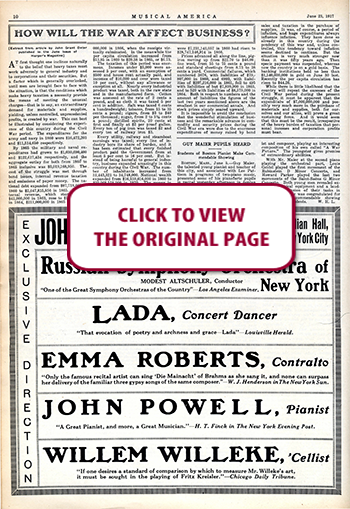 100 YEARS AGO IN MUSICAL AMERICA (200)
100 YEARS AGO IN MUSICAL AMERICA (200)
June 23, 1917
Page 10
HOW WILL THE WAR AFFECT BUSINESS?
[Extract from article by John Grant Dater published in the June Issue of Harper’s Magazine]
AT first thought one inclines naturally to the belief that heavy taxes must work adversely to general industry and to corporations and their securities. But a factor which is generally overlooked, until men are brought face to face with the situation, is that the conditions which make heavy taxation a necessity provide the means of meeting the unusual charges—that is to say, an extraordinary demand for materials and supplies, yielding, unless controlled, unprecedented profits, is created by war. This can best be illustrated by considering the experience of this country during the Civil War period. The expenditures for the army and navy in 1860 were $16,472,203 and $11,514,650 respectively.
By 1865 the military and naval expenditures had grown to $1,030,690,400 and $122,617,434 respectively, and the aggregate outlay for both from 1860 to 1865 inclusive was $3,019,168,950. The cost of the struggle was met through bond issues, internal revenue taxation and emissions of paper money. The national debt expanded from $87,718,660 in 1860 to $2,647,815,856 in 1865. The internal revenue, which started with $41,000,000 in 1863, rose to $117,000,000 in 1864, $211,000,000 in 1865 and $310,000,000 in 1866, when the receipts virtually culminated. In the meanwhile the per capita circulation increased from $13.85 in 1860 to $20.58 in 1865, or $6.73.
The taxation of this period was enormous. Incomes under $5,000 were assessed 5 per cent, with an exemption of $500 and house rent actually paid, and incomes of $10,000 and over were taxed 10 per cent, without any allowance or exception at all. Nearly every industrial product was taxed, both in the raw state and in the manufactured form. Cotton was assessed at the rate of 2 cents a pound, and as cloth it was taxed 5 per cent in addition. Salt was taxed 6 cents a hundredweight; tobacco, from 15 to 35 cents a pound; cigars, from $3 to $40 per thousand; sugar, from 2 to 3 ½ cents a pound; distilled spirits, 20 cents at first and finally at $2 per proof gallon. Every ton of pig iron was taxed $2 and every ton of railway iron $3.
Every utility, railway and steamboat earnings was taxed; every line of industry bore its share of burden, and it has been estimated that every finished product paid the Government from at least 5 per cent to 16 per cent. But instead of being harmful to general industry, business expanded amazingly in this country during the Civil War. The number of inhabitants increased from 31,443,321 to 34,748,000. National wealth expanded from $16,159,616,000 in 1860 to $30,068,518,000 in 1870. The money in circulation rose from $435,407,252 to $714,971,860. Savings bank deposits increased from $149,277,504 to $242,619,382. And the volume of exchanges at the New York Clearing House, which were $7,231,143,057 in 1860 had risen to $28,747,146,914 in 1866.
Prices advanced all along the line, pig-iron moving up from $22.70 to $46.08; fine wool, from 55 to 75 cents a pound and standard sheetings from 8.73 to 38 cents a yard. Commercial failures, which numbered 3676, with liabilities of $79,807,000 in 1860, and 6993, with liabilities of $207,210,000 in 1861, fell to 495 with liabilities of but $7,899,900 in 1863, and to 520 with liabilities of $8,579,000 in 1864. Both in respect to numbers and the amount of liabilities the figures of the last two years mentioned above are the smallest in our commercial annals. And stock prices simply soared upward.
It is impossible to avoid the conclusion that the wonderful stimulation of business and the remarkable advance in commodity and security prices during the Civil War era were due to the enormous expenditures of money raised by bond sales and taxation in the purchase of supplies. It was, of course, a period of inflation, and huge expenditures always influence inflation. They have done so already in this country during the pendency of this war and, unless controlled, this· tendency toward inflation seems destined to continue. But the situation is very much stronger now than it was fifty years ago. Then specie payment was suspended, whereas now the country is on a gold basis. The banking institutions held no less than $1,140,000,000 in gold on June 30 last. Recently the per capita circulation has risen to $44.26.
While there is little likelihood that the country will repeat the excesses of the Civil War period during the present struggle, it must be apparent that the expenditure of $7,000,000,000 and possibly very much more in the purchase of materials and supplies, both for ourselves and our allies, will prove a great sustaining force. And it would seem that this must be the result, irrespective of the heavy burden of taxation that personal incomes and corporation profits must bear.




 RENT A PHOTO
RENT A PHOTO





